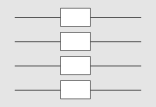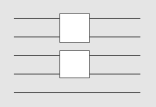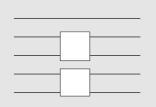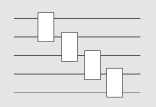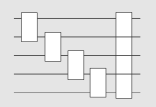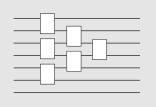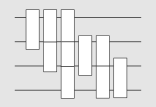qml.broadcast¶
- broadcast(unitary, wires, pattern, parameters=None, kwargs=None)[source]¶
Applies a unitary multiple times to a specific pattern of wires.
The unitary, defined by the argument
unitary, is either a quantum operation (such asRX()), or a user-supplied template. Depending on the chosen pattern,unitaryis applied to a wire or a subset of wires:pattern="single"applies a single-wire unitary to each one of the \(M\) wires:pattern="double"applies a two-wire unitary to \(\lfloor \frac{M}{2} \rfloor\) subsequent pairs of wires:pattern="double_odd"applies a two-wire unitary to \(\lfloor \frac{M-1}{2} \rfloor\) subsequent pairs of wires, starting with the second wire:pattern="chain"applies a two-wire unitary to all \(M-1\) neighbouring pairs of wires:pattern="ring"applies a two-wire unitary to all \(M\) neighbouring pairs of wires, where the last wire is considered to be a neighbour to the first one:Note
For 2 wires, the ring pattern is automatically replaced by
pattern = 'chain'to avoid a mere repetition of the unitary.pattern="pyramid"applies a two-wire unitary to wire pairs shaped in a pyramid declining to the right:pattern="all_to_all"applies a two-wire unitary to wire pairs that connect all wires to each other:A custom pattern can be passed by providing a list of wire lists to
pattern. Theunitaryis applied to each set of wires specified in the list.
Each
unitarymay depend on a different set of parameters. These are passed as a list by theparametersargument.For more details, see Usage Details below.
Warning
qml.broadcasthas been deprecated and will be removed in v0.40. Please useforloops instead.- Parameters
unitary (func) – quantum gate or template
pattern (str) – specifies the wire pattern of the broadcast
parameters (list) – sequence of parameters for each gate applied
wires (Iterable or Wires) – Wires that the template acts on. Accepts an iterable of numbers or strings, or a Wires object.
kwargs (dict) – dictionary of auxilliary parameters for
unitary
- Raises
ValueError – if inputs do not have the correct format
Usage Details
Broadcasting single gates
In the simplest case the unitary is typically an
Operation()object implementing a quantum gate.import pennylane as qml from pennylane import broadcast dev = qml.device('default.qubit', wires=3) @qml.qnode(dev) def circuit(pars): broadcast(unitary=qml.RX, pattern="single", wires=[0,1,2], parameters=pars) return qml.expval(qml.Z(0)) circuit([1, 1, 2])
This is equivalent to the following circuit:
@qml.qnode(dev) def circuit(pars): qml.RX(pars[0], wires=[0]) qml.RX(pars[1], wires=[1]) qml.RX(pars[2], wires=[2]) return qml.expval(qml.Z(0)) circuit([1, 1, 2])
Broadcasting templates
Alternatively, one can broadcast a built-in or user-defined template:
def mytemplate(pars, wires): qml.Hadamard(wires=wires) qml.RY(pars, wires=wires) dev = qml.device('default.qubit', wires=3) @qml.qnode(dev) def circuit(pars): broadcast(unitary=mytemplate, pattern="single", wires=[0,1,2], parameters=pars) return qml.expval(qml.Z(0)) print(circuit([1, 1, 0.1]))
Constant unitaries
If the
unitaryargument does not take parameters, noparametersargument is passed tobroadcast():dev = qml.device('default.qubit', wires=3) @qml.qnode(dev) def circuit(): broadcast(unitary=qml.Hadamard, pattern="single", wires=[0,1,2]) return qml.expval(qml.Z(0)) circuit()
Multiple parameters in unitary
The unitary, whether it is a single gate or a user-defined template, can take multiple parameters. For example:
def mytemplate(pars1, pars2, wires): qml.Hadamard(wires=wires) qml.RY(pars1, wires=wires) qml.RX(pars2, wires=wires) @qml.qnode(dev) def circuit(pars): broadcast(unitary=mytemplate, pattern="single", wires=[0,1,2], parameters=pars) return qml.expval(qml.Z(0)) circuit([[1, 1], [2, 1], [0.1, 1]])
In general, the unitary takes D parameters and must have the following signature:
unitary(parameter1, parameter2, ... parameterD, wires, **kwargs)
If
unitarydoes not depend on parameters (\(D=0\)), the signature isunitary(wires, **kwargs)
As a result,
parametersmust be a list or array of length-\(D\) lists or arrays.If \(D\) becomes large, the signature can be simplified by wrapping each entry in
parameters:def mytemplate(pars, wires): qml.Hadamard(wires=wires) qml.RY(pars[0], wires=wires) qml.RX(pars[1], wires=wires) @qml.qnode(dev) def circuit(pars): broadcast(unitary=mytemplate, pattern="single", wires=[0,1,2], parameters=pars) return qml.expval(qml.Z(0)) print(circuit([[[1, 1]], [[2, 1]], [[0.1, 1]]]))
If the number of parameters for each wire does not match the unitary, an error gets thrown:
def mytemplate(pars1, pars2, wires): qml.Hadamard(wires=wires) qml.RY(pars1, wires=wires) qml.RX(pars2, wires=wires) @qml.qnode(dev) def circuit(pars): broadcast(unitary=mytemplate, pattern="single", wires=[0, 1, 2], parameters=pars) return qml.expval(qml.Z(0))
>>> circuit([1, 2, 3])) TypeError: mytemplate() missing 1 required positional argument: 'pars2'
Keyword arguments
The unitary can be a template that takes additional keyword arguments.
def mytemplate(wires, h=True): if h: qml.Hadamard(wires=wires) qml.T(wires=wires) @qml.qnode(dev) def circuit(hadamard=None): broadcast(unitary=mytemplate, pattern="single", wires=[0, 1, 2], kwargs={'h': hadamard}) return qml.expval(qml.Z(0)) circuit(hadamard=False)
Different patterns
The basic usage of the different patterns works as follows:
Double pattern
dev = qml.device('default.qubit', wires=4) @qml.qnode(dev) def circuit(pars): broadcast(unitary=qml.CRot, pattern='double', wires=[0,1,2,3], parameters=pars) return qml.expval(qml.Z(0)) pars1 = [-1, 2.5, 3] pars2 = [-1, 4, 2] circuit([pars1, pars2])
Double-odd pattern
dev = qml.device('default.qubit', wires=4) @qml.qnode(dev) def circuit(pars): broadcast(unitary=qml.CRot, pattern='double_odd', wires=[0,1,2,3], parameters=pars) return qml.expval(qml.Z(0)) pars1 = [-5.3, 2.3, 3] circuit([pars1])
Chain pattern
dev = qml.device('default.qubit', wires=4) @qml.qnode(dev) def circuit(pars): broadcast(unitary=qml.CRot, pattern='chain', wires=[0,1,2,3], parameters=pars) return qml.expval(qml.Z(0)) pars1 = [1.8, 2, 3] pars2 = [-1, 3, 1] pars3 = [2, -1.2, 4] circuit([pars1, pars2, pars3])
Ring pattern
In general, the number of parameter sequences has to match the number of wires:
dev = qml.device('default.qubit', wires=3) @qml.qnode(dev) def circuit(pars): broadcast(unitary=qml.CRot, pattern='ring', wires=[0,1,2], parameters=pars) return qml.expval(qml.Z(0)) pars1 = [1, -2.2, 3] pars2 = [-1, 3, 1] pars3 = [2.6, 1, 4] circuit([pars1, pars2, pars3])
However, there is an exception for 2 wires, where only one set of parameters is needed. This avoids repeating a gate over the same wires twice:
dev = qml.device('default.qubit', wires=2) @qml.qnode(dev) def circuit(pars): broadcast(unitary=qml.CRot, pattern='ring', wires=[0,1], parameters=pars) return qml.expval(qml.Z(0)) pars1 = [-3.2, 2, 1.2] circuit([pars1])
Pyramid pattern
dev = qml.device('default.qubit', wires=4) @qml.qnode(dev) def circuit(pars): broadcast(unitary=qml.CRot, pattern='pyramid', wires=[0,1,2,3], parameters=pars) return qml.expval(qml.Z(0)) pars1 = [1.1, 2, 3] pars2 = [-1, 3, 1] pars3 = [2, 1, 4.2] circuit([pars1, pars2, pars3])
All-to-all pattern
dev = qml.device('default.qubit', wires=4) @qml.qnode(dev) def circuit(pars): broadcast(unitary=qml.CRot, pattern="all_to_all", wires=[0,1,2,3], parameters=pars) return qml.expval(qml.Z(0)) pars1 = [1, 2, 3] pars2 = [-1, 3, 1] pars3 = [2, 1, 4] pars4 = [-1, -2, -3] pars5 = [2, 1, 4] pars6 = [3, -2, -3] circuit([pars1, pars2, pars3, pars4, pars5, pars6])
Custom pattern
For a custom pattern, the wire lists for each application of the unitary is passed to
pattern:dev = qml.device('default.qubit', wires=5) pattern = [[0, 1], [3, 4]] @qml.qnode(dev) def circuit(): broadcast(unitary=qml.CNOT, pattern=pattern, wires=range(5)) return qml.expval(qml.Z(0)) circuit()
When using a parametrized unitary, make sure that the number of wire lists in
patterncorresponds to the number of parameters inparameters.pattern = [[0, 1], [3, 4]] @qml.qnode(dev) def circuit(pars): broadcast(unitary=qml.CRot, pattern=pattern, wires=range(5), parameters=pars) return qml.expval(qml.Z(0)) pars1 = [1, 2, 3] pars2 = [-1, 3, 1] pars = [pars1, pars2] assert len(pars) == len(pattern) circuit(pars)
